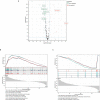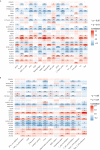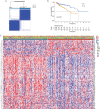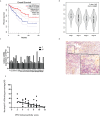An integrated bioinformatic investigation of mitochondrial energy metabolism genes in colon adenocarcinoma followed by preliminary validation of CPT2 in tumor immune infiltration
- PMID: 36177002
- PMCID: PMC9513322
- DOI: 10.3389/fimmu.2022.959967
An integrated bioinformatic investigation of mitochondrial energy metabolism genes in colon adenocarcinoma followed by preliminary validation of CPT2 in tumor immune infiltration
Abstract
Background: The prognosis for colon adenocarcinoma (COAD) today remains poor. Changes in mitochondria-related genes and metabolic reprogramming are related to tumor growth, metastasis, and immune evasion and are key factors in tumor genesis and development.
Methods: TCGA database was used to analyze the differentially expressed mitochondrial energy metabolism pathway-related genes (MMRGs) in COAD patients, and the mutation of MMRG in tumor cells, the biological processes involved, and the correlation with tumor immunity were also analyzed. Then, MMRG and MMRG-related genes were used to divide COAD patients into different subtypes, and immunocorrelation analysis and survival analysis were performed. Finally, univariate regression analysis and LASSO regression analysis were used to construct a prognostic risk model for COAD patients, which was verified by the GEO database and evaluated by Kaplan-Meier (K-M) and receiver operating characteristic (ROC) curves, and the correlation between the risk model and immunity and clinical subtypes based on MMRG was analyzed.
Results: In this study, the MMRG patterns and tumor immune microenvironment characteristics in COAD patients were systematically evaluated by clustering the expression of 188 MMRGs. We identified two subtypes of COAD with different clinical and immunological characteristics. Eight of the 28 differentially expressed MMRG genes were used to construct risk scores. ROC and K-M curves suggested that the risk model could well predict the prognosis of COAD patients, and the risk model was related to immune cell infiltration and immune function.
Conclusions: The two COAD subtypes identified by MMRG are helpful for the clinical differentiation of patients with different prognoses and tumor progressions, and the risk score can assist the clinical evaluation of patient prognosis. Our results suggest that CPT2 contributes to the recruitment and regulation of neutrophils in COAD. CPT2 may act as a valuable biomarker for COAD immunotherapy.
Keywords: CPT2; colon adenocarcinoma; energy metabolism; immune; mitochondrion.
Copyright © 2022 Cao, Lin, Fu, Niu, Yang and Cai.
Conflict of interest statement
The authors declare that the research was conducted in the absence of any commercial or financial relationships that could be construed as a potential conflict of interest.
Figures









Similar articles
-
Characterization of mitochondrial metabolism related molecular subtypes and immune infiltration in colorectal adenocarcinoma.Sci Rep. 2024 Oct 17;14(1):24326. doi: 10.1038/s41598-024-75482-2. Sci Rep. 2024. PMID: 39414905 Free PMC article.
-
To explore the prognostic characteristics of colon cancer based on tertiary lymphoid structure-related genes and reveal the characteristics of tumor microenvironment and drug prediction.Sci Rep. 2024 Jun 12;14(1):13555. doi: 10.1038/s41598-024-64308-w. Sci Rep. 2024. PMID: 38867070 Free PMC article.
-
Investigating gene signatures associated with immunity in colon adenocarcinoma to predict the immunotherapy effectiveness using NFM and WGCNA algorithms.Aging (Albany NY). 2024 May 13;16(9):7596-7621. doi: 10.18632/aging.205763. Epub 2024 May 13. Aging (Albany NY). 2024. PMID: 38742936 Free PMC article.
-
Copper metabolism patterns and tumor microenvironment characterization in colon adenocarcinoma.Front Oncol. 2022 Sep 20;12:959273. doi: 10.3389/fonc.2022.959273. eCollection 2022. Front Oncol. 2022. PMID: 36203457 Free PMC article.
-
Discovering biomarkers associated with infiltration of CD8+ T cells and tumor-associated fibrosis in colon adenocarcinoma using single-cell RNA sequencing and gene co-expression network.Front Immunol. 2025 Mar 31;16:1496640. doi: 10.3389/fimmu.2025.1496640. eCollection 2025. Front Immunol. 2025. PMID: 40230854 Free PMC article.
Cited by
-
A novel mitochondrial metabolism-related gene signature for predicting the prognosis of oesophageal squamous cell carcinoma.Aging (Albany NY). 2024 Jun 5;16(11):9649-9679. doi: 10.18632/aging.205892. Epub 2024 Jun 5. Aging (Albany NY). 2024. PMID: 38843392 Free PMC article.
-
Comprehensive analysis reveals signal and molecular mechanism of mitochondrial energy metabolism pathway in pancreatic cancer.Front Genet. 2023 Feb 6;14:1117145. doi: 10.3389/fgene.2023.1117145. eCollection 2023. Front Genet. 2023. PMID: 36814901 Free PMC article.
-
Prediction model of mitochondrial energy metabolism related genes in idiopathic pulmonary fibrosis and its correlation with immune microenvironment.Sci Rep. 2025 May 14;15(1):16801. doi: 10.1038/s41598-025-01759-9. Sci Rep. 2025. PMID: 40369105 Free PMC article.
-
Characterization of mitochondrial metabolism related molecular subtypes and immune infiltration in colorectal adenocarcinoma.Sci Rep. 2024 Oct 17;14(1):24326. doi: 10.1038/s41598-024-75482-2. Sci Rep. 2024. PMID: 39414905 Free PMC article.
References
-
- de Jong MC, Pulitano C, Ribero D, Strub J, Mentha G, Schulick RD, et al. . Rates and patterns of recurrence following curative intent surgery for colorectal liver metastasis: an international multi-institutional analysis of 1669 patients. Ann Surg (2009) 250:440–8. doi: 10.1097/SLA.0b013e3181b4539b - DOI - PubMed
Publication types
MeSH terms
Substances
LinkOut - more resources
Full Text Sources

